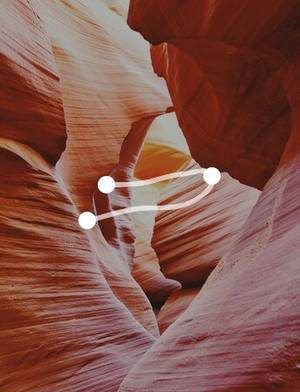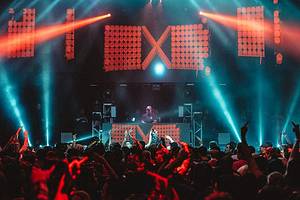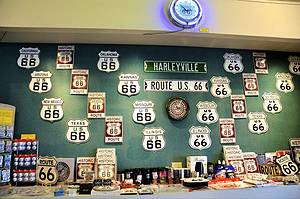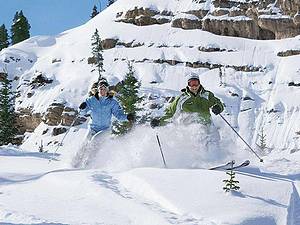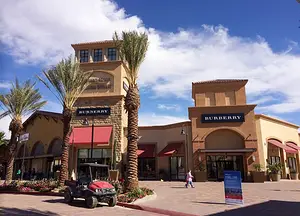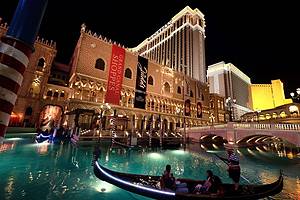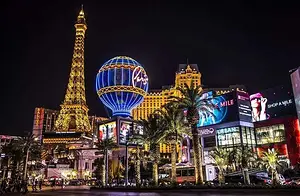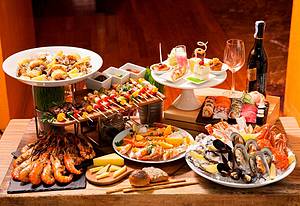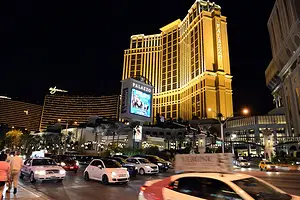Exploration of Various National Parks in Utah
10 cities |
24 attraction(s) |
total distance 640
km
 TIPS
TIPS
Day1
Day2
Day3
Day4
Day5
Day6
Day7
Day8
Day9
Day1: Los Angeles
3 attraction(s) ·
9 km
1
Universal Studios Hollywood, known as the "Entertainment Capital of Los Angeles," is a theme park located on CityWalk, right next to Universal City. It combines amusement rides with movie and TV show filming sets. You can step into the world of movies here, join famous animated characters and action heroes, and experience excitement and thrills with Transformers and Harry Potter.
Highlights:
• Adventure with Harry Potter
• Ride the Transformers 3D roller coaster and prepare for an epic battle like never before
• Take a legendary studio tour to explore the secrets of Hollywood movie production
• Experience the 360-degree 3D adventure of the Transformers, one of the most spectacular and thrilling 3D experiences in the world
• Ride the all-new Despicable Me 3D roller coaster and embark on a heartwarming and hilarious journey with Gru, his daughters, and the mischievous Minions
• Visit the "Special Effects Stage" to glimpse behind-the-scenes secrets of blockbuster movies
• In the world of "The Simpsons," ride the all-new virtual sky-high roller coaster for a fast and intense thrill
• Join Shrek and Donkey on an amazing adventure in the Shrek 4D experience.
7
km
2
Grauman's Chinese Theatre, originally named the Chinese Theatre, was renamed and acquired naming rights by Chinese appliance manufacturer TCL in 2013. It is one of the preferred premieres for Hollywood blockbusters. In addition to its unique architecture, the theatre's approximately 200 celebrity handprints outside the entrance are also a focal point of attention. In 1997, Jackie Chan became the first Chinese actor to leave his handprints here.
2
km
3
The Hollywood Walk of Fame is actually a pedestrian walkway on both sides of Hollywood Blvd, spanning 15 blocks (about 1.3 miles) from Gower Street to La Brea Avenue. The Walk of Fame was established in 1958 and initially had 1,500 stars representing celebrities in various fields like film, television, radio, theater, and music. New stars have been added since 1968, and there are currently over 2,500 stars.
Day2: Los Angeles > Las Vegas
5 attraction(s) ·
259 km
1
Calico was once a thriving silver mine during the peak of California's silver mining industry. It attracted over 2,500 young dreamers who labored under the scorching sun for their futures. In 1895, the silver price plummeted, and the mines turned into ruins, leading to the decline of Calico. It is now a ghost town with a desert climate, hot in summer and cooler from November to March. It still retains the charm of the old western era, with its old-fashioned bars, western streets, shops, and mining areas. The Mystery Shack, where gravity defies logic, is a fascinating place to visit, along with the silver mine ruins, shooting range, theater, and museum. Street performances and cowboy shootouts are also worth watching.
229
km
2
Crossing Las Vegas Boulevard on the south side of the long street is the most iconic building in the city. It expresses to tourists in an ancient style, "Welcome to beautiful Las Vegas, Nevada." Of course, when Betty Willis designed it in the late 1950s, it was not a retro building but at the forefront of global design styles. There is a road sign on the highway to Los Angeles, shining brightly on the front with the slogans "Drive carefully" and "Be right back" written on the back. Las Vegas Boulevard has not yet fully extended to the distant south. Now on its right side, there is a tourist attraction that has lacked proper management since the 1970s and has fallen into disrepair over the years. The centennial celebration in 2005 was a precious opportunity for Las Vegas to reflect its history. As a previously controversial city, it demonstrated greater value than expected. In commemoration of Las Vegas' centenary, the sign that was originally located in the middle of the road was restored and decorated, and was even used for cameo limited edition license plates for cars. Even on the north side of Las Vegas Boulevard, there is a small sign that says, "Welcome to the wonderful downtown Las Vegas." (But if you really go to downtown, you may find that the advertising slogans are somewhat exaggerated.) When you drive past the welcome sign, you will see luxury cars parked on the bustling street and excited tourists rushing out of the crowd onto the road to get a commemorative coin with their own portrait. Las Vegas is planning to build a parking lot right next to the sign because currently there are many illegal parking or even directly parked on the roadside. If you accidentally miss having your portrait on the coin, you can also order a miniature working model of the sign for $29.95. Order online at www.lvsignco.com or call 702-735-7446.
13
km
3
Las Vegas Boulevard, with a total length of 82.7 kilometers, is a major road in the Las Vegas Valley region of Nevada, USA. Known for its numerous casinos and hotels, the southern section of the road is referred to as the "Las Vegas Strip". Las Vegas Boulevard used to be part of US Route 91 in Nevada, which connected Los Angeles and Salt Lake City, but it has since been replaced by the new Interstate 15. Currently, Las Vegas Boulevard primarily handles local traffic, with some sections belonging to Nevada State Route 604.
3
km
4
Downtown Las Vegas is the central business district of Las Vegas. It used to be the main area for gambling before the famous Las Vegas Strip became the main casino hub. Downtown Las Vegas is home to numerous hotels, companies, cultural centers, historic buildings, and government departments, as well as residential and retail establishments. While it has lost some of its former glamour, it is still worth a visit to experience the history and past glory of Las Vegas. The main street in the downtown area is Fremont Street.
15
km
Day3: Zion National Park
3 attraction(s) ·
12 km
1
Zaien National Park's high point observation deck is accessible through a steep path that takes about eight miles round trip and four to six hours to complete. It is suitable for hikers with good physical fitness.
3
km
3
The Narrows is a rock climbing route along a mountain road, about one mile long. It is not very difficult and offers good scenery, with views of the Virgin River along the way.
Day4: Panguitch
1 attraction(s) ·
0 km
1
Bryce Canyon National Park is located near the town of Panguitch in Utah. It is not actually a true canyon, but a large natural amphitheater formed by erosion along the eastern edge of the Paunsaugunt Plateau. Its unique geological structures, called hoodoos, are formed by the erosion and deposition of sedimentary rocks by wind, water, and ice from rivers and lakes. The red, orange, and white rocks in the park create a unique natural landscape, earning it the nickname "hall of natural stone statues". The park offers magnificent sunrise views, and there is a scenic trail on the left side that stretches for over ten kilometers, allowing for multi-day hikes or camping in the canyon area. Mornings on the 2400-meter-high plateau can be quite cold, and the park's elevation is several hundred meters higher than the Grand Canyon, with cleaner and more transparent air. As soon as the sun appears on the horizon, the scenery is bathed in radiant light.
Day5: Page
3 attraction(s) ·
135 km
1
Lake Powell, named after the pioneer who first explored the river and proposed water development, is more than twice the size of Lake Mead. It boasts various red sandstone formations, arches, canyons, and a vast expanse of blue water, making it a major national recreation area in the southwestern United States. Construction of Lake Powell began in 1956 during the building of the Glen Canyon Dam, but it wasn't until 1980, after water from the rivers in Colorado and San Juan states, as well as the Escalante River, was diverted into it, that it was officially completed. In the movie "Gravity," the final landing site was filmed at Lake Powell, but the surrounding landscape was mostly digitally composited and differs greatly from the desert scenery around Lake Powell.
120
km
2
Horseshoe Bend is a horseshoe-shaped bend of the Colorado River near Page, Arizona, USA. It is located downstream from the Glen Canyon Dam and Lake Powell, 6 kilometers from Page. Horseshoe Bend can be reached by hiking 1.2 kilometers from US Route 89. The best viewing spot is on the steep cliffs above. The elevation above the cliffs is 4,200 feet, while the elevation of the Colorado River is 3,200 feet, resulting in a drop of 1,000 feet.
16
km
3
Antelope Canyon is one of the world's famous slot canyons, beloved by photographers. It is located in the northern part of Arizona, United States, closest to the city of Page. It is within the Navajo Nation Reservation. The canyon is divided into two separate sections, known as Upper Antelope Canyon and Lower Antelope Canyon.
Day6: Grand Canyon National Park
1 attraction(s) ·
0 km
1
Grand Canyon, one of America's landmarks, needs no introduction. When visiting Grand Canyon National Park, 90% of people will go to the South Rim. Located north of Tusayan, it is the park's southern entrance. The Canyon Visitor Information Center is located near Mather Point, where visitors can obtain route and attraction information. Continuing north will lead to Grand Canyon Village. At the Yavapai Observation Station in the northeast end of the village, you can see the panoramic view of the Grand Canyon, and there is also an interesting geological museum. Additionally, taking a helicopter tour of the canyon is a worthwhile experience, but it can be quite expensive, around $500. If you can afford it, go and try it to maximize your appreciation of the grandeur of the Grand Canyon in the shortest amount of time.
Day7: William Ca > Arizona
2 attraction(s) ·
69 km
1
Route 66, also known as the Mother Road, stretches from Chicago to Los Angeles and was once the main artery of the American economy. It witnessed the booming economic rise of the United States from the late 19th century to the early 20th century. It is also an important cultural element in many Western films, portraying cowboy duels or driving pickup trucks through the wild western deserts. Williams town is a classic Western town with Route 66 running through it, preserving many buildings from the early 20th century and bustling with bars. Country music plays at night while people enjoy beer, and sometimes there are impromptu performances with people dressed as cowboys on the streets. It is a great place to experience the history and culture of the American West.
69
km
2
This is a small town located along Route 66, with many remnants of Route 66 on the side of the highway behind the town.
Day8: Kingman > Las Vegas
2 attraction(s) ·
122 km
1
Route 66 Museum, Historic Route 66 Association, and Kingman Visitor Center are all located in this building, showcasing various historical stories and memorabilia related to Route 66.
122
km
2
Lake Mead is about an hour's drive from Las Vegas. It is the reservoir formed by Hoover Dam and is also the largest artificial lake in the United States. It is a popular destination for swimming, camping, boating, fishing, and water sports. It is also a great vacation spot and provides water supply for the entire Las Vegas area. Hoover Dam, named after President Hoover, was built in 1935 and was a marvel of engineering at that time, but it had significant impacts on downstream water flow and ecology.
Day9: Santa Monica > Los Angeles
4 attraction(s) ·
37 km
1
Venice Beach is like an endless carnival, famous for its street performers, marijuana culture, bohemian-style residents, and eclectic array of small shops. The shopping and dining experience on Albert Kinney Boulevard are unforgettable. Along the Venice boardwalk, there are magicians, street performers, fortune tellers, hawkers selling handmade crafts, street musicians, missionaries, and doctors soliciting marijuana purchases. It's advisable to leave the beach as the sun sets and return to a safe place in your car. It's also not recommended to dine near the beach after dark, as the area can be chaotic with frequent incidents involving homeless individuals begging or causing disturbances.
7
km
2
Santa Monica State Beach
Santa Monica is one of the most famous beaches in Los Angeles. Its pier features a small amusement park and has been a filming location for several movies and TV shows. You can enjoy water activities here, and if you like shopping, you can walk to Third Street Promenade in Santa Monica.
16
km
3
Rodeo Drive, known as the "World's Most Prestigious Residential Area," is the most famous city within a city in Los Angeles. It attracts countless tourists from around the world who are curious to explore its streets and alleys. Rodeo Drive, surrounded by world-renowned luxury boutiques, is particularly well-known. Hollywood movie stars, NBA basketball stars, world-famous artists, and wealthy tycoons from all over the world have all bought houses and land here. The most explosive news in Beverly Hills this year is that a young Chinese couple purchased a luxury mansion worth $34 million. Beverly Hills is not very large, covering about 6 square miles with a population of 35,000. Therefore, when visiting Beverly Hills, one can slowly admire the beautiful scenery here. Rodeo Drive, focused on luxury shopping, includes the most prestigious stores in Southern California, and each store has its unique architectural style. The motto here is, "Don't ask about the price when buying something; if you ask, it means you can't afford it." Every luxury jewelry and clothing brand can be found here, with the most magnificent displays. Each store is decorated in a grand and luxurious manner, resembling an art gallery. In recent years, the opening of "RodeoDrII" has increased the retail space of this famous shopping street by 60%. Its interior design is dazzling, with hand-carved marble and brass doors, towering arches that highlight the fountain's extraordinary grandeur. It is the world's most expensive shopping mall.
15
km
4
The observatory is located on the hilltop of Hollywood, providing a wide view. At night, you can overlook the splendid Los Angeles cityscape and the lights of many households. Inside the Hall of Science, there are many astronomical and physical pictures. On the top of the observatory, there is also a 12-inch giant telescope, the largest in California, for the public and travelers to explore the mysteries of the stars.

























